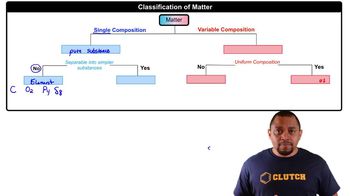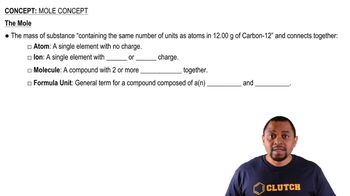At least 25 mg of tetrahydrocannabinol (THC), the active ingredient in marijuana, is required to produce intoxication. The molecular formula of THC is C21H30O2. How many molecules?
Ch.3 - Chemical Reactions and Reaction Stoichiometry
Chapter 3, Problem 45c
Give the empirical formula of each of the following compounds if a sample contains c.40.0% C, 6.7% H, and 53.3% O by mass.
 Verified step by step guidance
Verified step by step guidance1
Step 1: Assume a 100 g sample of the compound, which means you have 40.0 g of C, 6.7 g of H, and 53.3 g of O.
Step 2: Convert the mass of each element to moles by dividing by their respective atomic masses: C (12.01 g/mol), H (1.008 g/mol), and O (16.00 g/mol).
Step 3: Calculate the mole ratio of the elements by dividing each element's mole value by the smallest number of moles calculated in Step 2.
Step 4: If necessary, multiply the mole ratios by a whole number to get whole numbers for each element.
Step 5: Write the empirical formula using the whole number mole ratios as subscripts for each element.

Verified video answer for a similar problem:
This video solution was recommended by our tutors as helpful for the problem above.
Video duration:
2mWas this helpful?
Key Concepts
Here are the essential concepts you must grasp in order to answer the question correctly.
Empirical Formula
The empirical formula represents the simplest whole-number ratio of the elements in a compound. It is derived from the percentage composition of each element by mass, allowing chemists to understand the basic composition of a substance without detailing the actual number of atoms present.
Recommended video:
Guided course

Empirical vs Molecular Formula
Percentage Composition
Percentage composition refers to the mass percentage of each element in a compound. It is calculated by dividing the mass of each element by the total mass of the compound and multiplying by 100. This information is crucial for determining the empirical formula from a given sample.
Recommended video:
Guided course

Matter Composition
Mole Concept
The mole concept is a fundamental principle in chemistry that relates the mass of a substance to the number of particles it contains. One mole of any substance contains Avogadro's number (approximately 6.022 x 10²³) of entities, allowing for conversions between mass and moles, which is essential for calculating empirical formulas.
Recommended video:
Guided course

Mole Concept
Related Practice
Textbook Question
Textbook Question
Give the empirical formula of each of the following compounds if a sample contains a.0.0130 mol C, 0.0390 mol H, and 0.0065 mol O
Textbook Question
Give the empirical formula of each of the following compounds if a sample contains b.11.66 g iron and 5.01 g oxygen
Textbook Question
Determine the empirical formula of each of the following compounds if a sample contains a. 0.104 mol K, 0.052 mol C, and 0.156 mol O;
Textbook Question
Determine the empirical formula of each of the following compounds if a sample contains b. 5.28 g Sn and 3.37 g F;
Textbook Question
Determine the empirical formula of each of the following compounds if a sample contains c. 87.5% N and 12.5% H by mass.
